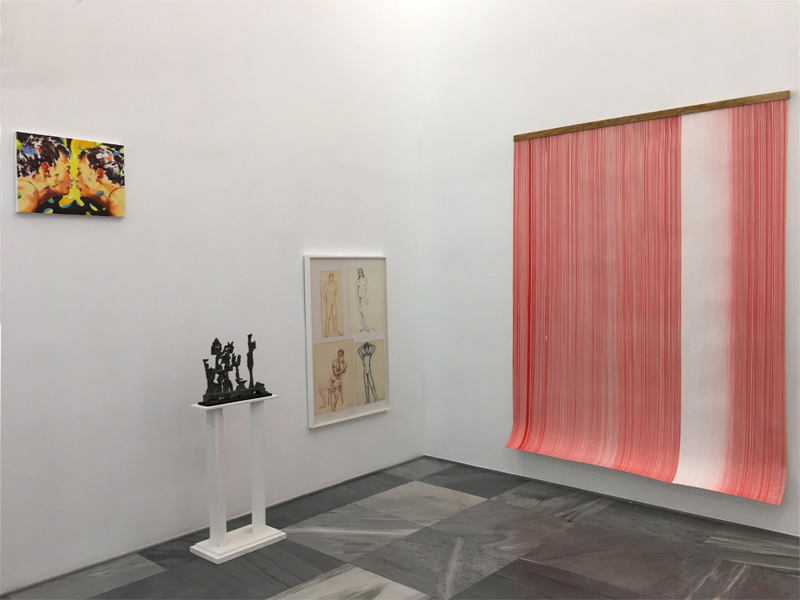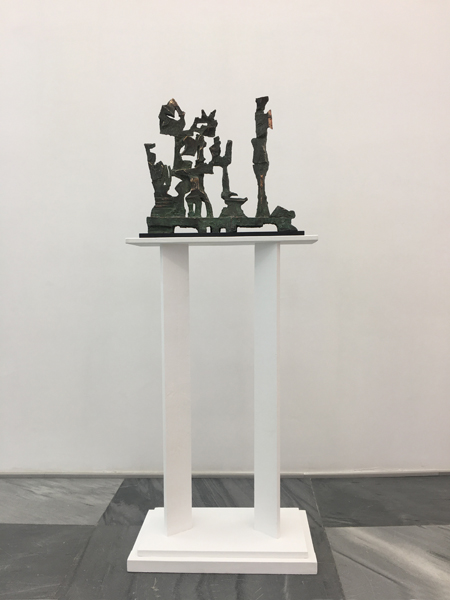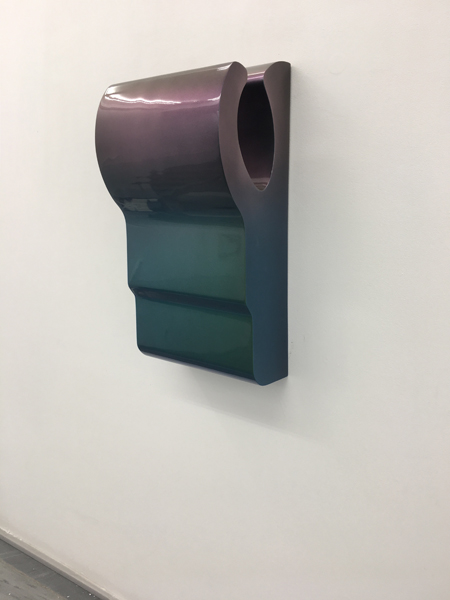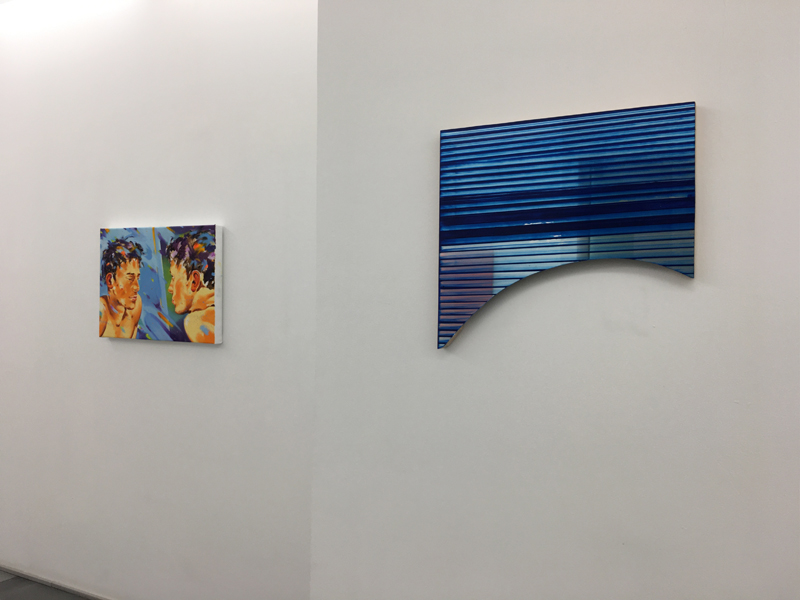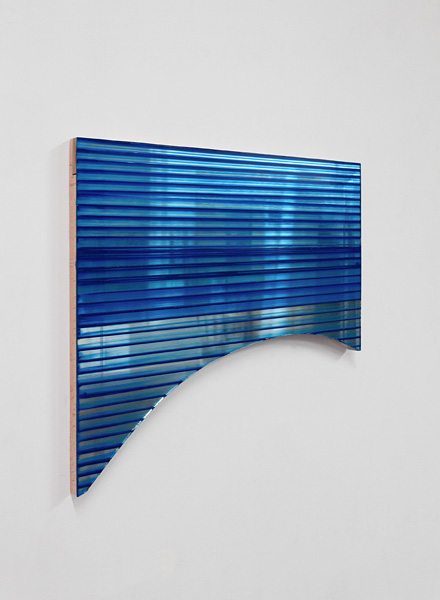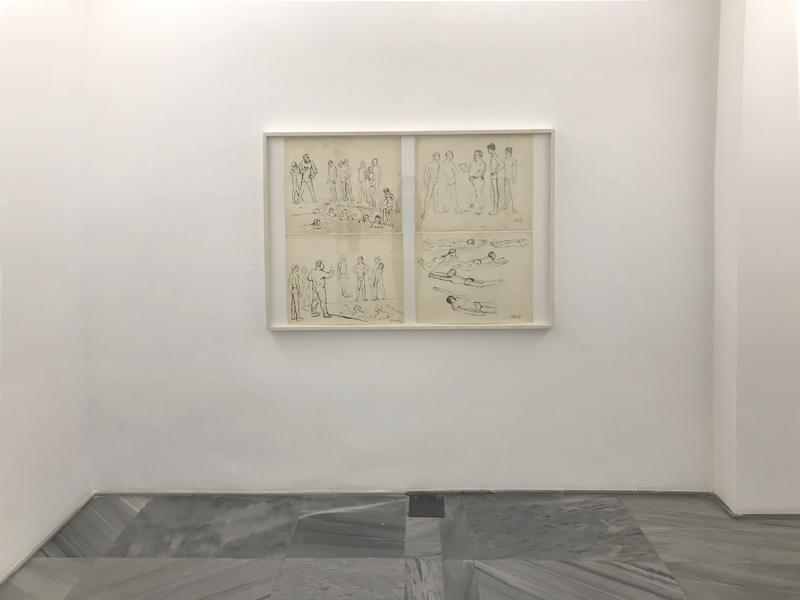facing B .- Veneta Androva, Norbert Bisky, Lena Marie Emrich, Sonja Eschefeld, Arne Schreiber and Jürgen Wittdorf. Curated by Stephan Koal
10/Apr/2021 - 05/Jun/2021

facing B is the title of Espacio Mínimo new exhibition at the gallery, curated by Stephan Koal, and with the participation of the artists: Veneta Androva, Norbert Bisky, Lena Marie Emrich, Sonja Eschefeld, Arne Schreiber and Jürgen Wittdorf.
About the title, curator wrote:
facing B: The opposite or the facing is marked with a “B”. B simply stands for the B on a licence plate – B for Berlin. B divided in itself, like the history of the city. B reflecting itself, like the history of the letter, that became its own mirror image following the reversal of writing direction.
Six artists that studied in B. Three generations, three women, three men, three Berlin-based art institutions. The AdK of the GDR (Akademie der Künste), the HdK/UdK (Universität der Künste) and the KHB (Weissensee Kunsthochschule Berlin). Figuration meets abstraction. Boomer, X and Y generations collide, repel and shove each other, complement each other, team up and become unlikely allies
A curator virtual tour.
A group of engineers, all of them men, develop a prototype for a female humanoid robot artist. AIVA is supposed to bring more diversity and a female perspective into the world. For this purpose, she is being fed vast amounts of data. A classic nude model helps AIVA to understand the human body and its shapes. The film culminates in a testosterone-ridden solo show of the new-born star of the art market. In her animated documentation, VENETA ANDROVA (Sofia, 1985), who studied with Else Gabriel at KHB, takes us on a journey into the still male-dominated art world.
Within the eyeshot of AIVA one finds a selection of JÜRGEN WITTDORF’s nudes (Karlsruhe, 1932 – Berlín, 2018) spanning three decades. Starting in the 1960s with young men posing for Wittdorf – seen from the front or from the back, arms crossed, behind their backs or raised up high. Groups of naked men talking or poolside in their swimming trunks. Over the more than five decades of Wittdorf’s artistic achievements, he worked with hundreds of models. One can tell from looking at his drawings that he was driven by a deep love for his subjects, not the prurience of Tom of Finland that he is often compared to.
Wittdorf died destitute in 2018, leaving behind an unsorted art treasure. Mostly drawings on paper. Through his graphic series like “Zyklus für die Jugend” (Cycle of Youth) and “Sport und Jugend” (Sport and Youth) he became a star in the 1960s and 1970s, following the collapse of the GDR he lost relevance and became unemployed. It took Andreas Sternweilers exhibition at Schwules Museum to catapult him back into the limelight. His 2020 exhibition at KVOST generated a huge echo in the media, making Wittdorf once again well-know beyond the gay community.
Wittdorf studied at HBK Leipzig and moved to Berlin in 1970. He became a master student at the AdK of the GDR under Lea Grundig, who died in 1977 during a Mediterranean trip. That same year SONJA ESCHEFELD (Klein Bünzow, 1948) started out as a master student of the sculptors Ludwig Engelhard and Wieland Förster after having studied sculpture at the KHB.
Much like Wittdorf’s nudes, Eschefelds still lifes are serial works, repeating motifs snatched from life and put on a pedestal. However, Eschefelds work is characterized by an unbridled courage. A courage that Wittdorf nearly had lost during his final years, choosing instead a manageable life of limitations. Eschefeld skilfully breaks down the boundaries between the figurative und abstraction, seemingly effortlessly mastering two mediums: painting and sculpture.
Her powerful paintings and sculptures are good together, each inspiring the other, broadening the others horizon. Where sculpture ends, painting begins and vice versa. In Eschefeld’s paintings mountains of bright shimmering scraps of colour are piled onto bases made for forming and presenting sculptures, permeating or overlapping each other. Her sculpture “Orpheus” that appears figurative at first glance, intensified by its historically portentous title, turns out to be an abstract structure leading to multi-faceted interpretations. Does it show animals and plants bowing to Orpheus’ singing, the fall of his beloved Eurydice or Orpheus himself being torn apart by maenads?
LENA MARIE EMRICH’s work (Göttingen, 1991) „Phone Sculptures“ seems to have been lifted from one of Eschefeld’s paintings. Emrich studied with Albrecht Schäfer at KHB, like Eschefeld and Androva. Twisted, smashed to endless splinters and placed on a pedestal are some screen protectors for mobile phones, the outside bearings of our thoughts and memories, that we protect like our own skin.
The broken protectors turn our everyday gripes into an abstract image, an artwork that draws in its observers. Emotionally and through movement, visual axes and incidence of light appearances and colouring change. Likewise, “Dolly” the replica of a hand dryer, painted and hung at the classic image height, turning it into a meaningless seemingly figurative object. The chameleon lacquer covering the sculpture changes its colour at the same pace as an animated weather map. In addition, “Dolly” is a popular name for hurricanes, pointing, in combination with the origin of the object, hung in countless airport toilets across the globe, to our sensitive environmental system.
Mirroring and ever-changing surfaces can also be found in ARNE SCHREIBER’s work (Potsdam, 1974). Schreiber studied at the UdK (then: HdK) at the same time as NORBERT BISKY (Leipzig, 1970). Schreiber with Kuno Gonschior, a representative of concrete art, and Bisky with the expressive figurative painter and sculptor Georg Baselitz. Both artists show new work created especially for this exhibition. Bisky and Schreiber have some things in common: both were born and raised in the GDR, developed an interest in painting at an early age and studied in “West-Berlin” shortly after the fall of the wall. Furthermore, they both create serial work and use glazing techniques. Other than that, their work could not be more oppositional. Schreiber non-presentational, Bisky figurative. Bisky seemingly telling us stories, Schreiber throwing us back on ourselves.
This is true for his new mirror works in a double sense. Following the reflex to recognize something in everything, our eyes are searching for stored data. Gloss and lines, but is there something else? We see the contours of our surroundings, of ourselves. We see lines and can’t be sure if they are flowing top down or from left to right. Schreiber disappears behind his artistic practice, subordinating himself to a strict system – but stays visible. Every line is drawn by hand, repetition forming a constant, yet the plan is firmly tied to the body’s ever-changing condition. The reflection duplicates itself in mirroring the process.
In the surfaces of Schreiber’s work the outlines of two young men, sprung from Norbert Bisky’s paint brush, can be anticipated. Two attractive heads, seen from the side, their curly hair neatly turned out against a blue background. One gazes at the other, whose eyes are closed. But he isn’t sleeping, rather, he appears to be waiting. Facing the other, trusting, maybe even devoted. The painting is part of a new series by Bisky titled “Spiegelbild” (mirror image), hinting at self-reflection. But the young man is no narcissist feasting upon and losing himself in his own image. His gaze is questioning, researching, striving for self-recognition. At the same time, it is demanding, full of expectation. What will happen, once I open my eyes?












